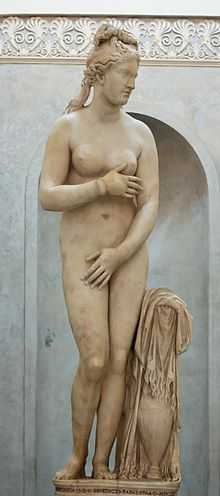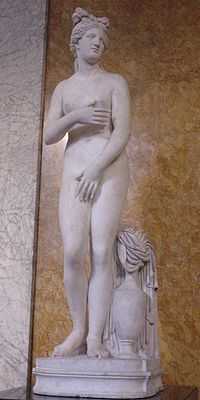Capitoline Venus

The Capitoline Venus is a type of statue of Venus, specifically one of several Venus Pudica (modest Venus) types (others include the Venus de' Medici type), of which several examples exist. The type ultimately derives from the Aphrodite of Cnidus. The Capitoline Venus and her variants are recognisable from the position of the arms—standing after a bath, Venus begins to cover her breasts with her right hand, and her groin with her left hand.
This original of this type (from which the following copies derive) is thought to be a lost 3rd- or 2nd-century BCE variation on Praxiteles' work from Asia Minor, which modifies the Praxitelean tradition by a carnal and voluptuous treatment of the subject and the goddess's modest gesture with both hands—rather than only one over the groin, in Praxiteles's original.
Principal example
The Capitoline Venus is a slightly over lifesize[1] marble statue of Venus. It is an Antonine copy of a late Hellenistic sculpture that ultimately derives from Praxiteles (Helbig 1972:128–30).
It was found on the Viminal Hill during the pontificate of Clement X (1670–76) in the gardens belonging to the Stazi near San Vitale.[2] Pope Benedict XIV purchased it from the Stazi family in 1752 and gave it to the Capitoline Museums,[3] where it is housed in a niche of its own—called "the cabinet of Venus"—on the ground floor of the Palazzo Nuovo on the Campidoglio.
The statue was on loan to the United States and was shown in the rotunda of the West Building of the National Gallery of Art in Washington, D.C. from June 8 to September 18, 2011.[4]

Its reputation vis-a-vis the Venus de' Medici in Florence grew only slowly, according to Haskell and Penny, fueled in part as a negative sensitivity to extensive restorations began to undermine the Florentine Venus. It was triumphantly removed to Paris by Napoleon under the terms of the Treaty of Tolentino; the Emperor commissioned a marble replica from Joseph Chinard, now at the Château de Compiègne. When the original was returned to the Vatican in 1816, the plaster cast that had replaced it during the Napoleonic era was shipped to Britain, where John Flaxman praised it to his students (Haskell and Penny 1981:319).

Other types
The Aphrodite of Menophantos (illustration, right) was found at the Camaldolese monastery of San Gregorio al Celio. It bears the signature[5] of Menophantos, a Greek sculptor, apparently of the 1st century BCE, of whom nothing more is known. The Camaldolese coenobites occupy the ancient church and monastery of S. Gregorii in Clivo Scauri founded by Pope Gregory the Great on his own family property, on the slope (clivus) of the Caelian Hill about 580. His foundation was dedicated in honor of the apostle Andrew. By the 10th century Gregory's name was appended to that of the apostle, whom he eventually supplanted.[6] The sculpture came into the possession of prince Chigi. Johann Joachim Winckelmann described this sculpture in his Geschichte der Kunst des Altertums (vol V, ch. II).[7]
The Campo Iemini Venus, another sculpture of the same model, was unearthed in the spring of 1792 among other sculptures in the excavation of a Roman villa at Campo Iemini, near Torvaianica, in Lazio (illustration, left). The dig was directed by the English dealer in Roman antiquities Robert Fagan (1761–1816) under the patronage of Prince Augustus, the Duke of Sussex in partnership with Sir Corbet Corbet of the British Museum. At the time of its discovery the English in particular found it superior to the Capitoline Venus. After restoration in Rome it was shipped to London, where Prince Augustus gave it to his brother the Prince Regent, who set it up at Carlton House. After his death, when Carlton House was replaced by a terrace of houses, William IV donated it to the British Museum.

[8] It is a 2nd-century Roman copy of Parian marble that was found at Baiae.
A version of Venus Pudica was also found in Hadrian Baths at Leptis Magna. The Hadrianic Baths were excavated in the 1920s, and the Lepcitanian copy of the Capitoline Venus was taken away to Europe by Mussolini, who gave it to the Nazi-leader Hermann Göring. The statue graced the bedroom of his country estate near Berlinn, Carinhall. It was finally returned to Libya in 1999. and today, it is in the National Archaeological Museum in Tripoli.
Further variants are at the Hermitage Museum, St. Petersburg,[9] as well as the similar Venus Tauride.[10][11]
Notes
- ↑ 1.93 m (6 ft. 3 ¾ in.).
- ↑ According to the memoirs of the antiquarian Pietro Santi Bartoli noted in Haskell and Penny 1981:318).
- ↑ Accession number MC 0409
- ↑ National Gallery of Art. "A Masterpiece from the Capitoline Museum, Rome: The Capitoline Venus"
- ↑ "Apo tis en troadi afroditis minofantos epoiei"
- ↑ Christian Hülsen, Le Chiese di Roma nel Medio Evo: S. Gregorii in Clivo Scauri
- ↑ William Smith, , A Dictionary of Greek and Roman Biography and Mythology, (1870) vol. II.1044.
- ↑ Illustration, National Archaeological Museum, Athens, gift of M. Embeirikos, 1924, acc. no. 3524; it is sometimes confused with a version of Antonio Canova's Venere Italica completed by Canova on behalf of the British connoisseur Thomas Hope (1769–1831), whose heirs sold it in 1917; Hope's Venus is conserved at the Leeds Art Gallery (Hugh Honour, "Canova's Statues of Venus", The Burlington Magazine, 114 No. 835 (October 1972), pp. 658-671, esp. p. 667).
- ↑ Atsma, Aaron.Of Type Capitoline Venus Theoi Project. Retrieved on May 13, 2008.
- ↑ Atsma, Aaron. "Tauride Venus". Theoi Project. Retrieved on May 13, 2008.
- ↑ "Aphrodite: Tauride Venus". State Hermitage Museum. Retrieved on May 13, 2008.
References
- Haskell, Francis and Nicholas Penny, 1981. Taste and the Antique: The Lure of Classical Sculpture 1500-1900. Yale University Press. Cat. no. 84.
- Helbig, Wolfgang. Führer durch die öffentlichen Sammlungen klassischer Altertümer in Rome. 4th edition, 1963–72, vol. II.
- Wilton, A. and I. Bignamini (editors.). Grand Tour: the lure of Italy in the eighteenth century London, Tate Gallery Publishing, 1996. no. 228, pp. 269–270. (the Campo Iemini Venus).
External links
| Wikimedia Commons has media related to Capitoline Venus (Musei Capitolini, Rome). |